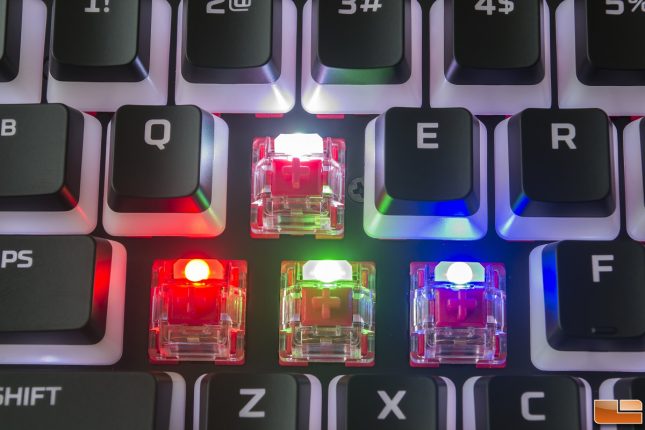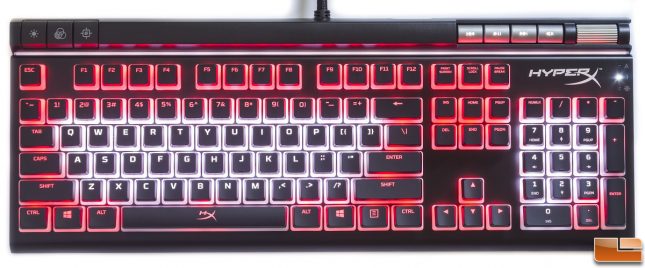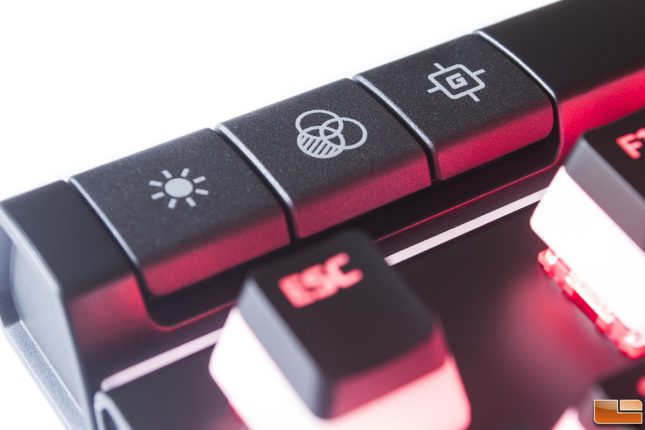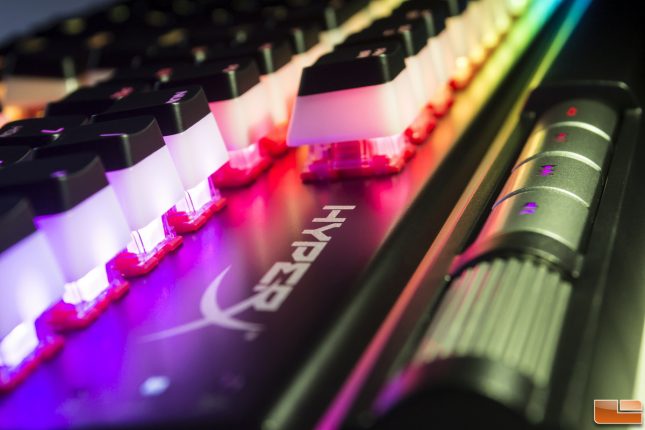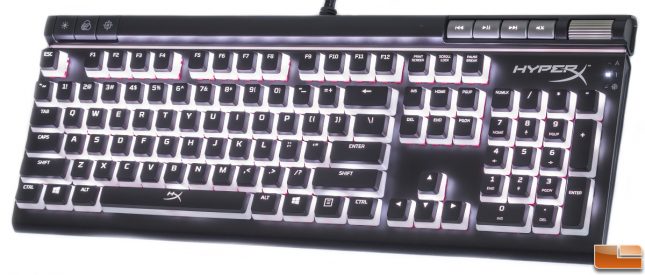HyperX Alloy Elite 2 Gaming Keyboard Review
Alloy Elite 2: Testing and Conclusion
I was impressed with the performance of the HyperX Red switches. These switches felt similar to Cherry MX Red switches and were smooth and quiet when typing. They provide a combination of speed and responsiveness with its 1.8 mm actuation point compared to the 2.0 mm on the Cheery MX Reds. Although this distance will be unnoticeable by the majority of players, it could be beneficial in some extreme cases. What is very impressive with these HyperX switches is the 80 million keystroke life cycle. This is more than what is on a standard Cherry MX Red switch, but only time can tell how long these switches will really last.
The LED bulb is exposed through the clear switch housing. This provides better light distribution and brightness compared to LEDs mounted inside the switch housing. Paired with the translucent Pudding keycaps, this provides brighter lighting across the surface of the keyboard.
With the keyboard powered on and illuminated, we can see how the Pudding keycaps light the keyboard surface. The light distributes well across the surface and makes the keycaps look as if they are hovering. At the lowest brightness level, the lighting on the Alloy Elite 2 is still pretty bright especially in a darker room. The LED illumination is even brighter at the highest brightness setting. This is probably one of the brightest gaming keyboards simply because of the translucent keycap design. The secondary functions on the keys do light up since most are labeled next to the primary functions.
Like its predecessor, the brightness, profile, and Game Mode buttons do not light up. Although not essential for functionality, it would have been nice to see these buttons light up especially since the previous model did not.
Although the Alloy Elite 2 introduces the HyperX Red linear mechanical switches with the Pudding keycaps, there are several other areas where there could have been improvements over the original Alloy Elite RGB. I have already mentioned how the brightness, profile, and Game Mode buttons do not illuminate. Because this keyboard still has the same bottom plate as the Alloy Elite RGB, it has mounts for a wrist rest. Unfortunately, this keyboard does not come with the wrist rest seen with the previous model. Perhaps HyperX did this to cut cost in redesigning a new bottom plate.
The HyperX NGenuity software still needs some work to it. There does not seem to be a way to change between profiles from the software. With the software open, I was unable to switch between profiles while pressing the profile button on the keyboard. I had to close the software, switch profiles on the keyboard, and then reopen the software. Sometimes I was unable to bring up the current profile on the keyboard to edit, which made it difficult to edit even the smallest detail. I would have to recreate the entire lighting theme and save it to one of the three onboard profiles.
Aside from a few hardware and software issues, the keyboard is definitely nothing to scoff at in terms of appearance. One thing I like about the light bar is the fact there are no dead zones. The light is evenly distributed, which makes it difficult to tell where the LED bulbs are. The light bar also compliments the Pudding keycaps very well, but it would have been perfect if it were a bit brighter.
Overall, the Alloy Elite 2 is a good keyboard for the money, but even better once the software matures to allow for more flexibility with customization. HyperX sort of went all out with this one since they designed this keyboard with their own switches, key font, and keycaps.
The HyperX Red switches have a 1.8 mm actuation point, which is 0.2 mm less than a standard Cherry MX switch. Total travel distance is also 3.8 mm in oppose to 4.0 mm on a Cherry switch. With speed and reliability, these switches should last for a long while. Of course, the only thing that can measure reliability is the test of time.
One thing I should mention about the signature HyperX font is the simplicity of it. Although appearance is subjective, the font is very easy to read and not overly designed. Also, with the Pudding keycaps and exposed LED bulbs, the light output may be higher than what some people are used to. Thankfully, the NGenuity software does allow for fine tune adjustments for brightness.
With an MSRP of $129.99, the HyperX Alloy Elite 2 is a competitive mechanical keyboard for someone looking for bright RGB illumination and longevity. I would definitely recommend this keyboard for anyone looking for a great looking keyboard with reliable switches.

Legit Bottom Line: The HyperX Alloy Elite 2 performs well and looks great with its Pudding keycaps that offers great RGB illumination.

